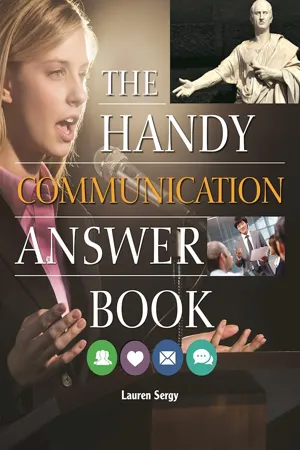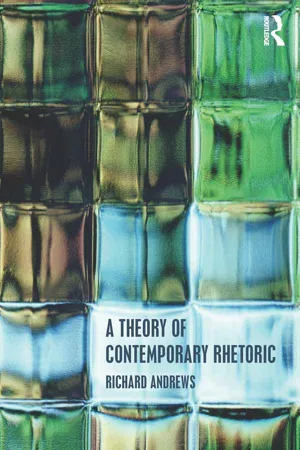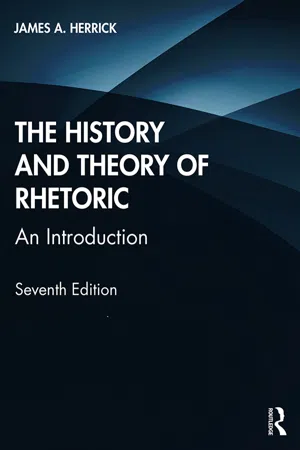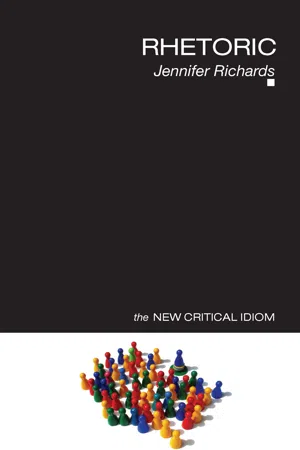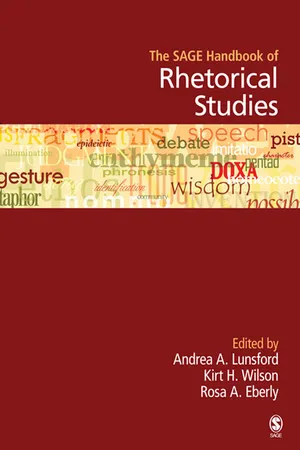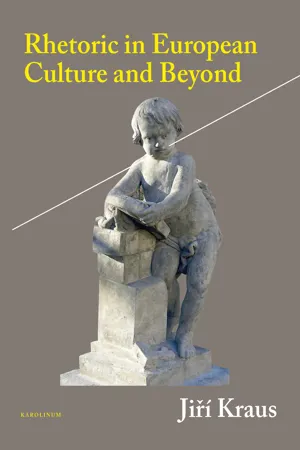Languages & Linguistics
Rhetoric
Rhetoric is the art of persuasive communication, involving the use of language to influence or persuade an audience. It encompasses the study of how language and symbols are used to convey meaning and sway opinions. Rhetoric examines the strategies and techniques employed in public speaking, writing, and other forms of discourse to achieve specific persuasive goals.
Written by Perlego with AI-assistance
Related key terms
10 Key excerpts on "Rhetoric"
- eBook - ePub
- Lauren Sergy(Author)
- 2017(Publication Date)
- Visible Ink Press(Publisher)
Rhetoric KEY IDEAS AND TERMS What is Rhetoric?Rhetoric is the art of persuasion and influence. Professor and classicist Angie Hobbs defines Rhetoric as “the art of persuading a specific audience to specific actions and beliefs through the use of language.” It is a discipline existing primarily within the language arts. While many modern Rhetoricians have expanded it to include the visual arts, for the purposes of this book it will be defined in its classical sense and will be referred to in its application to spoken or written language.Rhetoric is often seen as analogous to oratory, but there is an important distinction between the two. While the root of the word “Rhetoric” refers to the act of speaking, the discipline of Rhetoric is not limited to its application in public speaking. Rhetoric is concerned with the composition and expression of persuasive thoughts and ideas through language, while oratory is specifically concerned with the art and act of delivering a speech.A strong component of philosophy has been present in Rhetorical study throughout its history. Many scholars and philosophers have investigated how use of Rhetoric and language affects our development and understanding of truth, spirituality, science, the natural world, and culture.What is discourse?Discourse is the exchange of ideas or expression of thought in spoken or written formats. The term may also be extended to include exchange of thoughts or ideas through other media, such as through visual representation. Advertising, for example, often combines verbal or textual discourse with visual discourse to get its message across. While discourse often refers to a two-way exchange of thoughts and ideas, it may also take place through a one-way exchange of information. Even if the audience is incapable of responding to the person issuing the communication, they are still engaging in discourse by interpreting the message and assigning varied meaning to it. - eBook - ePub
- Richard Andrews(Author)
- 2013(Publication Date)
- Routledge(Publisher)
2Why Rhetoric?Etymology and History
The Oxford English Dictionary (OED) is a good place to start in an exploration of the etymology of Rhetoric—which will, in turn, reveal aspects of the meaning of the term and its uses over the centuries. First, Rhetoric is defined as “the art of using language so as to persuade or influence others; the body of rules to be observed by a speaker or writer in order that he [sic] may express himself with eloquence.” Immediately we can see that the traditional definition is inadequate to contemporary needs. Language , if associated with words only, is too narrow a term to compass the range of Rhetoric in a multimodal world; persuasion and influence may be Aristotelian formulations of the function of Rhetoric, but these intentions are only part of a wider, more generous conception of the art, which includes other functions of communication, such as informing, clarifying, and delighting (and a range of others). The body of rules indicates a form of Rhetoric that is not appropriate to the present. What it suggests is a reified set of prescriptions in the form of a manual of discourse. Such formulations fossilize quickly, and as they become outdated, give Rhetoric a bad name: that of a textbook, quasi-scientific approach. As we indicated as the end of the previous chapter, the metaphor that is more appropriate is that of light scaffolding rather than a body of rules. A speaker or writer might be better replaced by the notion of a “rhetor” or “maker” or “composer”—someone who has all the repertoire of resources available and who uses them to communicate a message to someone else (or to a group of people). The gendered “he” is clearly inappropriate, though it probably suggests not only convention but could refer to the supposedly male-centered nature of Rhetoric as opposed to Rhetorics, which embraces diversity. In this book, we use he/she or he and she alternately to indicate that the rhetor might be anyone—and we address issues of gender and Rhetoric in the chapter on power. Finally, with eloquence - eBook - ePub
- Tonya Krouse, Tamara F. O'Callaghan(Authors)
- 2020(Publication Date)
- Bloomsbury Academic(Publisher)
5 Rhetoric and CompositionOur first exposure to the term Rhetoric may have occurred after we watched a political speech or debate, when news commentators offered their analysis. Typically, commentators deploy the word with a negative connotation : they describe a politician’s words as “empty Rhetoric” or “just Rhetoric”—all style and no substance—or they use the term “Rhetoric” as a euphemism for the word “lie.” Even if the word Rhetoric is deployed more positively, it tends to suggest aggression: “tough” Rhetoric or “strong” Rhetoric—what we might call “fighting words.” While we may be very familiar with these contexts for the term Rhetoric, we may not have spent time examining Rhetoric as a topic of study or thinking about how Rhetoric informs the ways in which we communicate. At its most basic level, Rhetoric is simply “the art of persuasion” regardless of the intent.In contrast to the term Rhetoric, the term composition may not seem to have relevance in our daily lives. Although there are “composition notebooks” in the school supplies aisle, or a professor might refer to our college writing course as a “composition course,” composition is not a term in common usage, and it can sound old-fashioned or obsolete to modern ears.This chapter focuses on finding the connections between Rhetoric (approaches that speakers or writers use in language to reach their audiences ) and composition (the practical techniques we use to organize our ideas and to express ourselves in written language). Additionally, it delves into the significant role that Rhetoric and Composition as a field plays not only in nineteenth- and twentieth-century attempts to define the discipline - eBook - ePub
The History and Theory of Rhetoric
An Introduction
- James A. Herrick(Author)
- 2020(Publication Date)
- Routledge(Publisher)
Other activities also bring us into the realm of Rhetoric. Business transactions, from marketing strategies to contract negotiations, involve persuasive efforts. As McCloskey has pointed out, many people make their living by means of their abilities as persuasive speakers or writers. Nor is education immune from Rhetorical influence. You often are aware that a professor is advocating a point of view in a lecture that ostensibly presents simple “information,” or that classmates argue with one another hoping to persuade others to their point of view. As a matter of fact, you have been reading an extended persuasive case for the importance of studying Rhetoric. Textbooks, it should come as little surprise, often have a persuasive agenda embedded within them.Efforts at persuasion mark many, perhaps all, of our interpersonal activities. In fact, we even persuade ourselves . The internal Rhetoric of “arguing with yourself” accompanies most of life’s decisions, big or small. Though our experiences may leave us leery of persuasion, it is also an important component of our occupational, social, and private lives.12Now, back to Rhetoric. If Rhetoric is, in part, the systematic study of persuasion, recognizing how crucial persuasion is to daily life may suggest that this art deserves our attention. To acknowledge what we might call “the pervasiveness of persuasiveness” is not to condemn persuasion or Rhetoric. Rather, it is to begin to appreciate the centrality of this activity to much of life, and to recognize that human beings are Rhetorical beings. At this point, it will be important to develop a more precise definition of Rhetoric.Defining Rhetoric
Scholars have advanced a variety of insightful definitions of our topic. Rhetoric scholar James J. Murphy has suggested “advice to others about future language use” as one way of defining Rhetoric.13 Murphy’s definition implies prior study of the topic Rhetoric that has resulted in a set of tested theories and reliable techniques. Classicist George Kennedy defines Rhetoric more broadly as “the energy inherent in emotion and thought, transmitted through a system of signs, including language, to others to influence their decisions or actions.”14 - De Man values the work of earlier structuralists such as Barthes and Genette because their emphasis on the conventionality of meaning ‘explodes the myth of semantic correspondence between sign and referent’ (6). In so doing, it frees linguistic analysis from the ‘the authority of reference’ which context- and content-led Anglophone literary critics have started to turn back to, and it shifts attention to the ‘literary dimensions of language’ which a preoccupation with referentiality obscures (5). Yet, he is also concerned with the way in which Barthes and Genette collapse the difference between Rhetorical and grammatical structures in their literary analyses ‘without apparent awareness of a possible discrepancy between them’ (6). De Man maintains the distinctiveness of grammatical and figurative language, and of linguistics and Rhetoric. Both ‘arts’ represent the systematic study of language, but this is about as far as the similarities go. For instance, Rhetoric is usually described as an ‘art’ or ‘practice’, whereas linguistics is defined as a ‘science’. In these contrasting self-definitions there lies a world of difference. Grammar underpins logic: no statement is logically true unless it is grammatically correct. Rhetoric, in contrast, is perhaps better understood, de Man suggests, in terms of Kenneth Burke’s ‘deflection’: ‘any slight bias or even unintended error’. Rhetorical figures subvert the ‘consistent link between sign and meaning that operates within grammatical patterns’ (8).Addressing this problem does not mean returning to the ‘old Rhetoric’. Rather, for de Man it means extending our conception of Rhetoric to take account of the advance of linguistics; hence, his conception of Rhetoric in terms of a ‘semiological enigma’. To argue that Rhetoric is an art of persuasion is to assume a linguistic model in which someone acts upon someone else. De Man has no confidence in the intrinsic communicability of language or in our ability either to express ourselves unambiguously or to discover the final meaning of a text. In spite of our best efforts, he argues, we cannot control meaning. Attending to Rhetoric as ‘semiological enigma’ realizes this; moreover, it enables de Man to place Rhetorical and grammatical meaning in productive tension.Let us consider his second, more challenging example of this tension. De Man’s first example of a Rhetorical question undermines our confidence in the meaning of a grammatical sentence. His second example reveals how an unplanned literal reading can interrupt an intended metaphorical reading which privileges ‘unity’ between sign and content, image and reality. This example of a Rhetorical question is the final line of ‘Among School Children’, a late poem by W. B. Yeats (1865–1939): ‘How can we know the dancer from the dance?’ (Yeats 1990:261–63). This line is ‘usually interpreted’, he remarks, ‘as stating, with the increased emphasis of a Rhetorical device, the potential unity between form and experience, between creator and creation’. In this respect, he adds, it ‘could be said that it denies the discrepancy between the sign and the referent from which we started out’ (11). De Man does not offer to explain ‘Among School Children’, though he does assume his reader’s familiarity with it or, at the very least, their access to it; and for this reason I shall outline the poem so we can understand the significance both of its usual interpretation and of de Man’s disagreement with that.
- eBook - ePub
- Ivo Strecker, Stephen Tyler, Ivo Strecker, Stephen Tyler(Authors)
- 2009(Publication Date)
- Berghahn Books(Publisher)
Rhetoric has been used in differing, sometimes inconsistent ways, both in popular parlance and even within the work of a single theorist—all of which, however, are bound up with particular Western understandings of the nature of language and speech in the world. To see why, let us now turn to a brief review of some of those understandings.There is of course a vast historical literature on the theory and practice of Rhetoric.2 In this and the following section I wish to draw attention to two points that are evident from that history. The first point arises from an observation by Roland Barthes, as quoted and extended upon by Chaim Perelman in the opening passage of his book The Realm of Rhetoric:In his remarks on ancient Rhetoric, Roland Barthes (1970: 194) correctly observed that “Rhetoric must always be read in its structural interplay with its neighbors—grammar, logic, poetics and philosophy.” I would add that in order best to define and situate Rhetoric, we must clarify its relationship to dialectic. (Perelman 1982: 1)The relational character of the category of “Rhetoric” is evident from the moment of its birth, which seems to have taken place in the works of Plato. Before that there was of course a term rhētor , meaning “politician who speaks publicly.” But according to the historian of Rhetoric Edward Schiappa, in all of known Greek literature there are no attested instances of the term rhētorikē prior to Plato’s use of it in the Gorgias:Prior to the fourth century logos and legein were used to describe what would later be called Rhetoric. Both terms are far broader in their meanings than the term rhētorikē , hence the appearance of the term rhētorikē signals a new level of specificity and conceptual clarity concerning the different verbal arts. (Schiappa 1991: 45)But it was not only for “conceptual clarity” that Plato coined the term. Rather, Schiappa argues, he did so in order to distinguish his own teachings—which he called by the then also recently coined term philosophia —from those of others, including Isocrates and the Sophists, and to devalue the latter (Schiappa 1991: 45; Nienkamp 2001: 143 n.23). At a more specific level, Plato was also concerned to distinguish between Rhetoric and dialectic (dialektikē , another term apparently coined by Plato himself), where “the goal of dialectic is truth, while the goal of Rhetoric is belief or persuasion rather than truth or knowledge” (Nienkamp 2001: 283 ; italics in original).4 - eBook - ePub
- Andrea A. Lunsford, Kirt H. Wilson, Rosa A. Eberly(Authors)
- 2008(Publication Date)
- SAGE Publications, Inc(Publisher)
In the United States, the study of Rhetoric has survived remarkably better than in Europe. Not only was classical Rhetoric already in the 19th century more strongly represented in the academic curriculum but the development of modern Rhetorical approaches has also been more prolific. Among the most important 20th-century Rhetoricians are I. A. Richards, Richard Weaver, and Kenneth Burke, whose broad aims and ambitions vary from developing a culture based on the ideal and the truth to helpful insights for correcting misunderstandings. Burke’s (1950) definition of Rhetoric as “the use of words by human agents to form attitudes or to induce actions in other human agents” comes close to the traditional definitions concentrating on “persuasion.” Because he views persuasion as a result of “identification,” he considers identification as a necessary complement. The argumentative angle of Rhetoric, connecting Rhetoric with the ability to find the appropriate means of persuasion and to use of them in a speech, has been predominant for a long time and has even been considered paradigmatic.In the last decades of the 20th century, a powerful revaluation of Rhetoric has taken place in the study of argumentation that revised the irrational and even antirational image of Rhetoric that had come into being during the past centuries. It is remarkable that the rehabilitation of Rhetoric started at about the same time in various countries. A considerable time after Perelman and Olbrechts-Tyteca’s pioneering work, in the United States several argumentation scholars defended the rational qualities of Rhetoric. Joseph W. Wenzel (1980), for one, would like to give Rhetoric full credit, but then emphatically in relation with logic and more in particular dialectics. In France, Olivier Reboul (1990) argued in favor of giving Rhetoric a satisfactory position in the study of argumentation beside dialectics. He regarded Rhetoric and dialectic as different disciplines, which display some overlap: Rhetoric applies dialectic to public discussions while dialectic is at the same time a part of Rhetoric because dialectic provides Rhetoric with intellectual tools. In Germany, Josef Kopperschmidt (1989) took the reappraisal of Rhetoric a considerable step further: He argued that, viewed from a historical perspective, Rhetoric is the central concern of argumentation theorists. Such examples of revaluing Rhetoric can be noticed on a much broader scale. In many cases, tribute is paid to Perelman, and more in particular to Perelman and Olbrecht-Tyteca’s book, The New Rhetoric - eBook - ePub
Academic Constraints in Rhetorical Criticism of the New Testament
An Introduction to a Rhetoric of Power
- J. David Hester Amador(Author)
- 1999(Publication Date)
- Sheffield Academic Press(Publisher)
museful, insofar as its analytical, critical and compositional aspects are embedded within a process of continuing creativity, reflection, evaluation and the recognition that ‘truth’ is relative to the ‘contexts’ of persuasion in which ‘truth’ asserts its hegemony, ‘contexts’ which demand to be understood [not ‘uncanny’].However, an important [and fair] question to ask at this point would be: are there lacunae, blind spots in the theory as we have so far developed it? I believe so, and the first to come to mind is the emphasis on invention and arrangement shown in recent theories of Rhetoric to the near exclusion of other important aspects of communicative exchange. This results in an important distortion which should be corrected: since its inception, Rhetoric also included concerns of style, memorization and delivery. While these additional canons were the result of the particular form in which Rhetorical performance was primarily engaged at the time, and while arguably the emphasis upon concerns of elocution and style have been problematic throughout the history of Rhetoric, 205 I nevertheless herein wish to embrace at least the tendencies which they embody: a concern with the standards of Rhetorical performance as dictated by the communicative form in which a persuasive act takes place. To turn to Aristotle: as we have so far explored Rhetoric in the works of New Testament Rhetorical-critical scholars, we have sacrificed Rhetoric on the altar to the God of logos, whereas a great deal of Rhetoric (as both performance and analysis) may have to deal with ethos and pathos. [No, not quite.] The forms of power are manifold, and it is often not only rational appeal, but emotional (mythic) and authoritative appeal that helps to secure conviction (and perhaps more importantly: persuasion). [Better; continue.] Part of a rhetor’s power may just lie in her/his style (both personal appearance and comportment, as well as selection of discursive tropes and figures), in her/his delivery (including settings and communicative forms selected for publication and presentation), 206 even in memorization (one of the most important ethos elements of the power of speakers is the command they show of their subject). [Still too ‘text’ centered.] One suspects that a great deal of the wariness that modern Rhetorical theory shows toward elocution is due, in part, to the prominence of the written material medium in the academented circles in which such theorizing takes place. Here, written material dominates critical attention as both means of production and object of analysis. Additionally, one suspects that the wariness toward elocution is grounded in the fear of the re-emergence of the techne tradition in which rules of performance became the dominant concern of Rhetoric instruction (as it now is with the advent of ‘composition studies’ as the major forum of Rhetorical research and application in America) [which is not meant to be a criticism from a superior ‘theorist’ position]. This is an amazing turn of events for elocution, which Antonio Capmany once called ‘such an absolute necessity to the orator that without it he is incapable of producing his ideas, and all his other talents, however great they may be, are entirely useless’.207 As one scholar has put it, ‘modern disapproval of stylistic Rhetoric… is wholly unhistorical. If you cannot pick up a list of the figures and read it through avidly, thinking of all the instances of their application and re-creation in Petrarch or Racine or Shakespeare or Milton, then you ought not to be studying Rhetoric .’208 - eBook - ePub
- Angela Goddard, Neil Carey(Authors)
- 2017(Publication Date)
- Routledge(Publisher)
Although audiences and the values embedded in their wider cultural contexts are seen in this chapter as important factors in analysing Rhetoric, less attention is given to the ‘media effects’ and ‘audience studies’ approaches that are more closely aligned with the second tradition. This is because the techniques associated with the analysis of public address, rooted as they are in the writings of Classical Greek scholars, are thought to be less familiar to readers of this book than studies that measure media effects or audience responses. THE ORIGINS OF Rhetoric The study of discourse is often seen as a modern practice. But Rhetoric, which is in essence about techniques of persuasion and therefore closely connected with discourse, dates back to the philosophical figures of Ancient Greece. The best known of these within the field of Rhetoric is Aristotle, largely because his writings were preserved and translated: you can still read his Art of Rhetoric which dates from the fourth century bce. Aristotle was not the originator of Rhetorical studies, but a later summariser of Rhetoric’s nature. The origins of Rhetoric are thought to lie with an earlier field of philosophy called Sophism, but few records remain of the Rhetorical thinking and arguments of the Sophists. What we have, instead, is a wealth of writing from objectors to the Sophists’ Rhetorical work, objections that have imbued the modern term ‘sophistry’ with negative connotations of manipulation and duplicity - eBook - ePub
- Jirí Kraus(Author)
- 2015(Publication Date)
- Karolinum Press, Charles University(Publisher)
We encounter the term “Rhetoric” across a wide range of its meanings, both in everyday life and when reading purely academic texts. Rhetoric has gone so far as to reclaim its theme: Rhetoric itself and its history. In the early 1960s, Heinrich Lausberg published his two-volume Handbuch der literarischen Rhetorik, which presented an image of Rhetoric as a remarkably comprehensive and structured system of knowledge, rendered through the careful selection of quotes from classical authors’ works. Chaim Perelman, a Belgian philosopher of Polish origin, discovered the Rhetoric of argumentation which won him respect among philosophers. Rhetoric and philosophy were singularly reconciled in the works of prominent thinkers, such as Paul Ricoeur, Hans-Georg Gadamer and Jürgen Habermas. Rhetoric was rediscovered by the representatives of French structuralism and Groupe μ authors, associated with the University of Liège, in Belgium. The significance of Rhetoric in the past and present is explained in the book, In Defense of Rhetoric (1988), by Brian Vickers, an English academic working in Zurich, as well as in erudite essays by Carl Joachim Classen, a classical philologist from Göttingen University. An informed insight into the history of Rhetoric and its structure is presented in Heinrich F. Plett’s works as well as in the syncretistic publication Grundriss der Rhetorik. Geschichte – Technik – Methode (3 rd edition in 1994) by Gert Ueding and Bernd Steinbrink. In the 20 th century, a new scientific superpower appeared on the stage of Rhetorical research: the United States. The United States astonished not only in its complex approach to the discipline, but also by its own remarkable traditions, grounded both in American history’s fight for democracy and in the theoretical works by Ivor Armstrong Richards, Richard McKeon, Kenneth Burke, who in turn inspired contemporary scholars, such as Nancy Struever, James Murphy, George Kennedy and Thomas Conley
Index pages curate the most relevant extracts from our library of academic textbooks. They’ve been created using an in-house natural language model (NLM), each adding context and meaning to key research topics.
